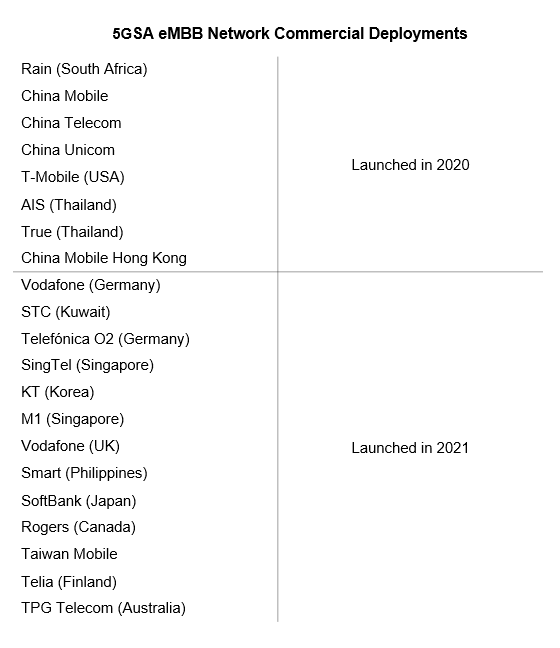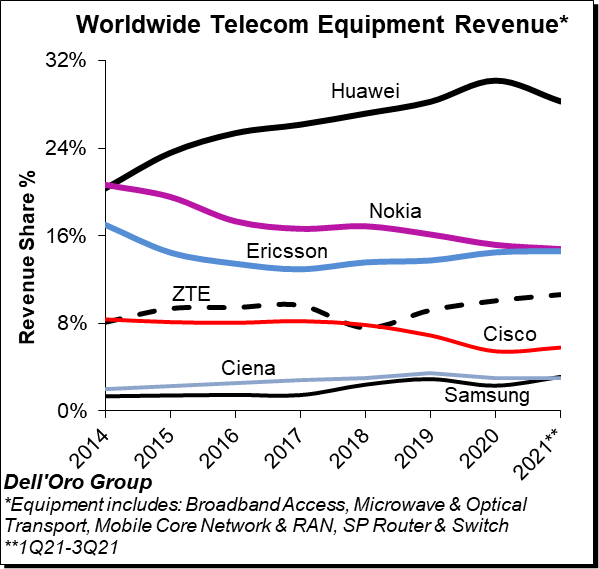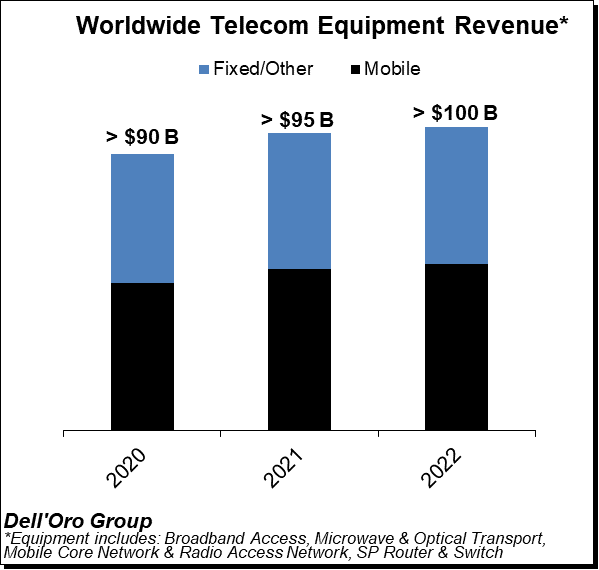Data centers are the backbone of our digital lives, enabling the real-time processing of and aggregation of data and transactions, as well as the seamless delivery of applications to both enterprises and their end customers. Data centers have been able to grow to support ever-increasing volumes of data and transaction processing thanks in large part to software-based automation and virtualization, allowing enterprises and hyperscalers alike to adapt quickly to changing workload volumes as well as physical infrastructure limitations.
Despite their phenomenal growth and innovation, the principles of which are being integrated into service provider networks, data centers of all sizes are about to undergo a significant expansion as they are tasked with processing blockchain, bitcoin, IoT, gigabit broadband, and 5G workloads. In our latest forecast, published earlier this month, we expect worldwide data center capex to reach $350 B by 2026, representing a five-year projected growth rate of 10%. We also forecast hyperscale cloud providers to double their data center spending over the next five years.
Additionally, enterprises are all becoming smarter about how to balance and incorporate their private clouds, public clouds, and on-premises clouds for the most optimal and efficient processing of workloads and application requests. Similar to highly-resilient service provider networks, enterprises are realizing that the distribution of workload processing allows them to scale faster with more redundancy. Despite the general trend towards migrating to the cloud, enterprises will continue to invest in on-premises infrastructure to handle workloads that involve sensitive data, as well as those applications that are very latency-sensitive.
As application requests, change orders, equipment configuration changes, and other general troubleshooting and maintenance requests continue to increase, anticipating and managing the necessary changes in multi-cloud environments becomes exceedingly difficult. Throw in the need to quickly identify and troubleshoot network faults at the physical layer and you have a recipe for a maintenance nightmare and, more importantly, substantial revenue loss due to the cascading impact of fragmented networks that are only peripherally integrated.
Although automation and machine learning tools have been available for some time, they are often designed to automate application delivery within one of the multiple cloud environments, not across multiple clouds and multiple network layers. Automating IT processes across both physical and virtual environments and across the underlying network infrastructure, compute and storage resources have been a challenge for some time. Each layer has its own distinct set of issues and requirements.
New network rollouts or service changes resulting in network configuration changes are typically very labor-intensive and frequently yield faults in the early stages of deployment that require significant man-hours of labor.
Similarly, configuration changes sometimes result in redundant or mismatched operations due to the manual entry of these changes. Without a holistic approach to automation, there is no way to verify or prevent the introduction of conflicting network configurations.
Finally—and this is just as true of service provider networks as it is of large enterprises and hyperscale cloud providers—detecting network faults is often a time-consuming process, principally because network faults are often handled passively until they are located and resolved manually. Traditional alarm reporting followed by manual troubleshooting must give way to proactive and automatic network monitoring that quickly detects network faults and uses machine learning to rectify them without any manual intervention whatsoever.
Automating a Data Center’s Full Life Cycle
As the size and complexity of data centers continue to increase and as workload and application changes increase, the impact on the underlying network infrastructure can be difficult to predict. Various organizations both within and outside the enterprise have different requirements that all must somehow be funneled into a common platform to prevent conflicting changes to the application delivery layer all the way to the network infrastructure. These organizations can also have drastically different timeframes for the expected completion of changes largely due to siloed management of different portions of the data center, as well as different diagnostic and troubleshooting tools in use by the network operations team and the IT infrastructure teams.
In addition to pushing on their equipment vendor and systems integrator partners to deliver platforms that solve these challenges, large enterprises also want platforms that give them the ability to automate the entire lifecycle of their networks. These platforms use AI and machine learning to build a thorough and evolving view of underlying network infrastructure to allow enterprises to:
-
- Support automatic network planning and capacity upgrades by modeling how the addition of workloads will impact current and future server requirements as well as the need to add switching and routing capacity to support application delivery.
- Implement network changes automatically, reducing the need for manual intervention and thereby reducing the possibility of errors.
- Constantly provide detailed network monitoring at all layers and provide proactive fault location, detection, and resolution while limiting manual intervention.
- Simplify the service and application provisioning process by providing a common interface that then translates requests into desired network changes.
Ultimately, one of the key goals of these platforms is to create a closed-loop between network management, control, and analysis capabilities so that changes in the upper-layer services and applications can drive defined changes in the underlying network infrastructure automatically. In order for this to become a reality in increasingly complex data center network environments, these platforms must provide some critical functions, including:
-
- Providing a unified data model and data lakes across multiple cloud environments and multi-vendor ecosystems
- This function has been a long-standing goal of large enterprises and telecommunications service providers for years. Ending the swivel-chair approach to network management and delivering error-free network changes with minimal manual intervention are key functions of any data center automation platform.
- Service orchestration across multiple, complex service flows
- This function has also been highly sought-after by large enterprises and service providers alike. For service providers, SDN overlays were intended to add in these functions and capabilities into their networks. Deployments have yielded mixed, but generally favorable results. Nevertheless, the principles of SDN continue to proliferate into other areas of the network, largely due to the desire to streamline and automate the service provisioning process. The same can be said for large enterprises and data center providers.
- Providing a unified data model and data lakes across multiple cloud environments and multi-vendor ecosystems
Although these platforms are intended to serve as a common interface across multiple business units and network layers, their design, and deployment can be modular and gradual. If a large enterprise wants to migrate to a more automated model, it can do so at a pace that is suited to the organization’s needs. The introduction of automation can be done first at the network infrastructure layer and then introduced to the application layer. Over time, with AI and machine learning tools aggregating performance data across both network layers, correlations between application delivery changes and their impact on network infrastructure can be determined more quickly. Ultimately, service and network lifecycle management can be simplified and expanded to cover hybrid cloud or multi-vendor environments.
We believe that these holistic platforms that bridge the worlds of telecommunications service providers and large enterprise data centers will play a key role in helping automate data center application delivery by providing a common window into the application delivery network as well as the underlying network infrastructure. The result will be the more efficient use of network resources, a reduction in the time required to make manual configuration changes to the network, a reduction in the programming load for IT departments, and strict compliance with SLA guarantee to key end customers and application provider partners.



 Positive market sentiment in the third quarter was driven by strong growth in RAN and Broadband Access, which was more than enough to offset weaker trends in Optical Transport.
Positive market sentiment in the third quarter was driven by strong growth in RAN and Broadband Access, which was more than enough to offset weaker trends in Optical Transport.